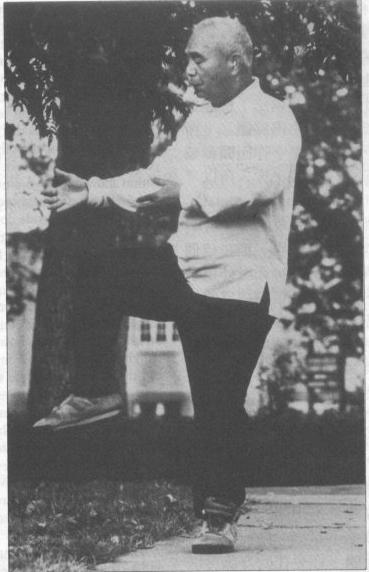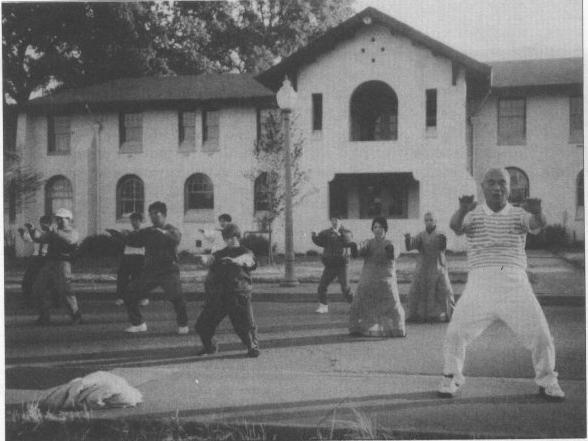 |
|
太極拳教
授潘柔世
Taijiquan instructor Pan Roushi
|
「無極是真空,太極是妙有。由無極而生太極,太極動而生陽,太極靜而生陰。動極而靜,靜極而動。」這是自然的
法則。
太古之時,天地未開,文字更未出現,宇宙就是個大大的○字,也就是無極。
其後,無極生太極,太極生兩儀,兩儀就是陰陽,陰為柔,陽為剛,陰陽配合,在太極這個圓圈中,上下左右運轉動作,動中有靜,靜中有動,一點圓光可擴展至千
萬世界,此即太極圈之原理。
七百餘年前,張三丰研究開創出一套「剛中帶柔,柔中帶剛」的拳法,因其運用太極原理,故稱之為太極拳,以太極
圖的圓心代表人體丹田。學習太極拳,最重要的就是練此丹田之氣,配合動作,綿綿不斷的運功。丹田位於臍下一寸二分之處,須自此「正丹田」練習吐納。先吐
氣,由丹田將氣吐至腹部,再徐徐往上送氣,腹部肌肉同時內縮,縮至腹肌完全緊貼,無可再緊,如一「凹」字,此時肛門自動收緊。須注意,腹肌縮進時,上半身
完全放鬆,一點也不緊張,接著吸氣,腹部逐漸撐開,如一「凸」字,肛門任其自然。此時力氣不能用到肩膀上,否則無法進步。
練習丹田呼吸,速度越慢越好。練習久了,肛門自然時時緊縮,但全身是放鬆的。練到身、手、氣三項配合一致,心
念自然定靜,此即動中有靜;又在靜中,全身筋絡肌肉放鬆,才能發出功夫,此是靜中有動。能做到這一步,才是真功夫,正如太極圖之圓圈代表圓滿,完成。依我
三十餘年習拳之經驗,練太極拳若是認真學習,大約要三年四個月以上,才能達到這個程度。
學習太極拳,亦須配合靜坐。靜坐時,運用丹田呼吸之原理,自然容易靜心息慮,全身放鬆,萬緣放下。有時但覺所
坐之位雖僅一席,亦可延伸至無限,人人本具之靈光,更可擴展至千萬世界。
佛菩薩頭上都有光圈,這光也是圓的。「圓」正是太極要旨,也就是混沌未開時的那個「○」字。因此,太極拳招式
雖多,但招招不離「圓」。以丹田為中心,自腰部使力,手、腳、身無論上下左右如何挪移轉動,皆渾然成一圓形。學習太極拳若能掌握要點,日久自然心領神會,
得到太極拳之精髓,不僅袪病延年,更可煉精化氣,煉氣化神。
我的大學教育是在日本完成,因此與日本各界頗有接觸。據我了解,太極拳傳入日本後,演變出種種武術,如著名的
「相撲」。相撲的競技場地是圓形,兩人相撲正如同太極圖中之陰陽互動。
相撲選手除了胯下之外,不著任何衣物。兩人較勁時,無法抓對方衣物借力取巧,因此全憑真功夫角力。比賽時,不
分重量,不分年齡,選手全靠丹田之氣與腰力競技。柔道,合氣道又自相撲變化而來,同樣發源於太極拳,也是以腰力為主,掃腿,掌手等招式,更直接源自太極
拳。
無論學習哪一種武術,都要明暸「武」字的真正涵義。「武」這個字,從字面上看,是止戰戈,不是要拼命打架的。
武術的最高境界,就是追求和平。就這一點而言,太極拳的每一招式,最終目的就是「止戈」,深深契合人類追求世界和平的精神。
我從四十歲起正式拜佛學習太極拳,三十餘年的練拳生涯,對我而言,是一條追求正統之路。我抱著一顆真誠的心,
在這條道路上追求真理。我從太極拳中領悟了許多人生和宇宙的至理,我的領悟常在許多典籍中得到印證。
孔子曾說:「朝聞道,夕死可也。」一心追求真理的人,的確有這份氣概將生死置諸度外,我個人深有同感。
|
|
“The Limitless is True Emptiness; the Absolute is
Wonderful Existence. The Limitless gives rise to the Absolute. When
there is movement in the Absolute, yang is produced. When the movement
reaches its limit, it becomes still. At the limit of stillness, there
is movement.” This is a natural law.
O In extreme antiquity,
before the world had been
formed and long before the appearance of written language, the universe
was just a great, big zero—that is, the Limitless 無極 wuji. Later, the
Limitless gave rise to the Absolute 太極 taiji, and the Absolute in turn
produced the Two Primal Forces 兩儀 liangyi, yin and yang. Yin is soft
and yang is hard. Within the circle of the Absolute, yin and yang
mutually revolve so that movement contains stillness and stillness
contains movement. This tiny sphere of light can be expanded to
encompass millions of worlds; this is the basic principle of Taijiquan.
More than 700 years ago, Mr. Zhang Sanfeng
pioneered a set of shadowboxing movements in which the hard and soft
are mutually inclusive. Since his system was based on the principles of
taiji, he called it Taijiquan. The circular heart of the taiji diagram
represents the dantian, in the lower abdomen of the human body. The
practice of Taijiquan consists primarily of smelting the energy (qi) in
the dantian through an uninterrupted sequence of movements.
One should practice inhaling and exhaling using
the dantian, which is located a little over an inch below the navel.
When one exhales, the dantian should send the air to the abdomen and
then slowly upwards. The abdominal muscles should contract until they
are as tight as possible, so that one’s abdomen sinks inwards. The
rectum will naturally contract as well. Yet while the abdomen is pulled
tight, the upper body should be completely relaxed. On the inhalation,
the abdomen should gradually bulge outward. Make sure the shoulders
don’t tense up, for if they do, one cannot progress.

太極拳的每一招式,最終目的就是「止
戈」,深深契合人類追求世界和平的精神。
Each Taijiquan
move is aimed at “halting the spears.” This is in close
accord with the
spirit of humanity quest for world peace.
In practicing breathing with the dantian, the
slower one goes, the better. After long practice, one will be able to
maintain the rectum contracted at all times, while the rest of the body
is relaxed. When the body, hands, and breath can work in coordination,
the mind will naturally become calm; this is stillness within movement.
In the state of stillness, one’s muscles and tendons will be relaxed
and one will be able to apply true gongfu (skill)—this is movement
within stillness. This level of accomplishment is true gongfu, the
perfection symbolized by the circular taiji diagram. Based on over
thirty years of experience, I would say that if one practices
diligently, it takes about three years and four months to reach this
level of skill.
The practice of Taijiquan should go hand-in-hand
with meditation. If one breathes with the dantian during meditation, it
is easy to quiet the mind, relax the body, and let go of all external
conditions. One may sometimes feel one’s sitting space expanding
without bounds. Likewise, each person’s inherent spiritual light can
reach millions of worlds.
Every Buddha and Bodhisattva is crowned with a
circular halo of light. The circle is the principle of the Absolute; it
is the zero, which represents the nebulous mass before the formation of
the universe. Although the movements of Taijiquan are many, none are
apart from the circle. As one exerts strength from the waist, with the
dantian as one’s center of gravity, the movements of one’s hands, feet,
and body are all naturally circular in form. If one maintains these
essential guidelines in one’s practice, one will naturally fathom and
attain the essence of Taijiquan. In addition to preventing sickness and
insuring a long life, one will be able to transform essence into
energy, and energy into spirit.
Because I graduated from college in Japan, I have
been in close contact with that country. After Taijiquan became known
in Japan, it evolved into various forms of martial arts, such as the
well-known sport of Sumo wrestling, in which two men duel in a
wrestling ring, mirroring the movements of the yin and yang fishes in
the taiji diagram.
The wrestlers wear only a loincloth, so they
cannot gain a grip on each other by grabbing each other’s clothing.
They must rely entirely on true skill. During the match, contestants
are not separated by weight or age; dantian energy and muscular
strength are the only factors of competition. Judo and Aikido, which
also emphasize the power of the waist, are martial art forms that
evolved from Sumo and thus have their origin in Taijiquan. Their hand
and foot movements originate directly from Taijiquan.
No matter what form of martial arts one practices,
one should understand the meaning of the word “martial” 武 wu. If we
look at the elements of the character, the meaning is to stop war, not
to keep on fighting. The highest state in martial arts is actually the
pursuit of peace. In light of this, we can say that each Taijiquan move
is aimed at “halting the spears"止戈. [These are the two elements that
make up the word “martial” 武.] This is in close accord with the spirit
of humanity’s quest for world peace.
My formal training in Taijiquan began when I was
forty. In the thirty-some years since then, I have walked the path of
orthodox practice, sincerely seeking the truth. Taijiquan has given me
many insights into the truths of life and the universe, and I have
found confirmation for these insights in various spiritual and
religious texts.
Confucius once said, “If I hear of the Way in the
morning, I can die without regret in the evening.” This is the attitude
of a sincere seeker of truth who is not concerned about birth and
death. I share his feelings.
|